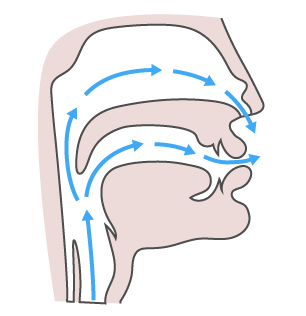What is resonance? What does it have to do with speech?
When you talk, sound is made in your voice box (larynx). The sound vibration moves through your mouth and nose to:
- become louder
- be shaped into sounds and words
Resonance is the way your speech sounds as it goes through your:
- mouth (oral resonance)
- nose (nasal resonance)
When do sounds move through the mouth and nose?
When you talk there is an ideal balance for sounds that are made through the nose and the mouth. When you say:
- m, n, or ng (nasal sounds), the sound moves through the nose
- vowels or other English (non-nasal) consonants, most of the sound moves through the mouth
How does this happen?
The roof of the mouth (palate) is hard at the front and soft at the back. The soft palate is made up of a group of muscles in your mouth that open and close to control the amount of sound that goes through your nose when you talk. When the soft palate is open, sound goes through your nose (see image below). This is called Nasal Ariticulation.
When the soft palate is closed, sound goes out your mouth (see image below). This is called Oral Articulation.

This means that:
- the soft palate moves to stop air from going through the nose when you say vowels and non nasal consonants
- the soft palate stays down to let air move through the nose when you say nasal sounds
What are hyponasal and hypernasal resonance?
- Hyponasal resonance means that too little sound may come through your nose. This may happen when it’s plugged (e.g. cold, allergies).
- Hypernasal resonance means that too much sound comes through your nose. This happens when the soft palate doesn’t stop air from going through the nose.
What causes hypernasal resonance?
It can be caused when the:
- soft palate is too short or doesn’t close properly
- nerves or muscles of the soft palate are damaged
When the soft palate doesn’t close properly, it’s called velopharyngeal incompetence, or VPI.
How can resonance be improved?
- Speech therapy can improve how you make speech sounds and improve your resonance without correcting the VPI.
- A speech device (prosthetic appliance) worn in the mouth will improve resonance when you wear it. You may also need to train the soft palate to close better.
- Surgery can be done, but usually only if the soft palate has physical defects or if the hypernasal resonance is moderate or severe.
- A combination of the above can be done.
If you have concerns about your child’s resonance:
Contact your health provider or a speech-language pathologist.
Where to go get help
For more information about how speech-language pathologists and audiologists can help, contact:
- Your doctor, public health nurse, or other health provider
- Your local health centre
